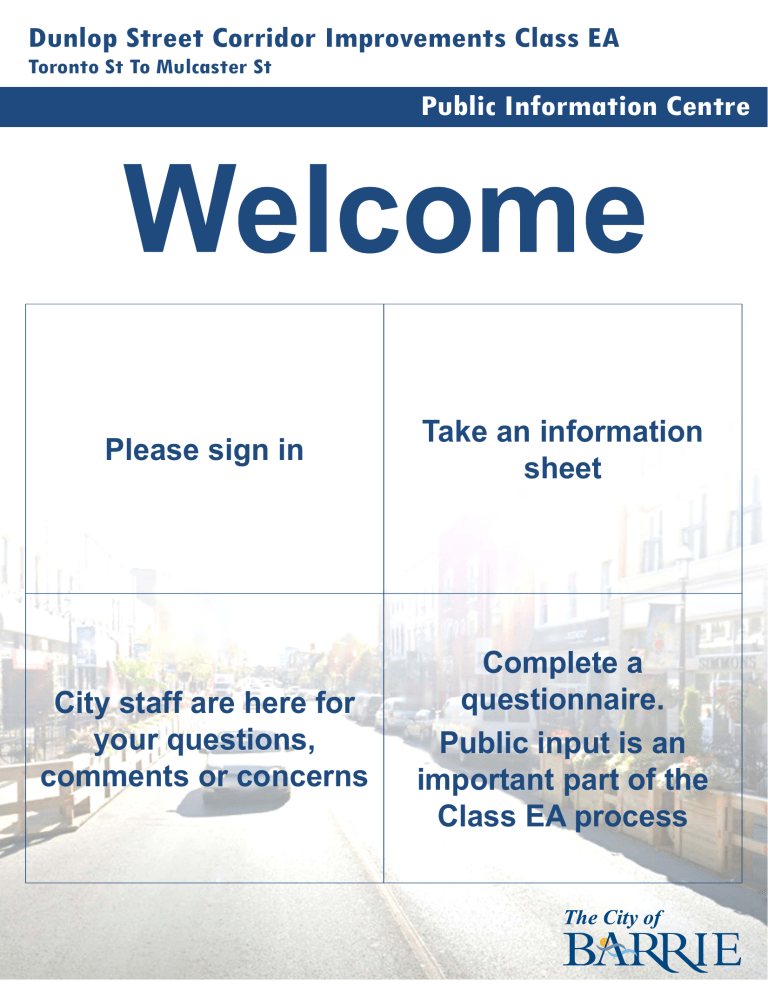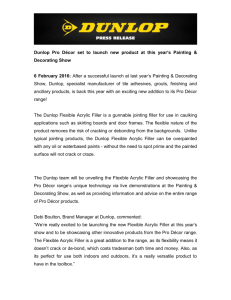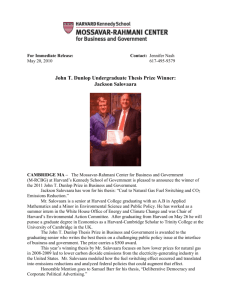Info Boards - City of Barrie
advertisement

Dunlop Street Corridor Improvements Class EA Toronto St To Mulcaster St Public Information Centre Please sign in Take an information sheet City staff are here for your questions, comments or concerns Complete a questionnaire. Public input is an important part of the Class EA process Dunlop Street Corridor Improvements Class EA Toronto St To Mulcaster St Public Information Centre Study Area The Study Area encompasses the entire downtown core of the City. It is a centre for culture, dining, nightlife, as well as an established neighborhood and home to many businesses. For the purposes of this study, the Study Area is comprised of the following geographic areas: Dunlop Street Right-of-Way This is the focus of the study for improvements to the street itself. The limits of this area are between Toronto Street and Mulcaster Street and encompass the entire right-of-way. Ross/Collier/Bayfield Intersection Due to the potential loss of east-west vehicular capacity on Dunlop Street (for design alternatives that reduce vehicular capacity on Dunlop Street), the realignment of this intersection is being studied to assist in providing increased east-west capacity. The realignment was previously studied as part of the Waterfront/Downtown Transportation Improvements Class EA . The previously developed alternatives are being re-evaluated because of changes to land use at the intersection. Overall Study Area This is the broader area for consideration with respect to traffic impacts and possible mitigation measures through the consideration of additional lanes on Collier Street for design alternatives that reduce vehicular capacity on Dunlop Street. Study Purpose and Objectives • • • • • • Propose improvements to the existing streetscape to enhance active transportation; Assess the existing transportation system within the study area with respect to proposed improvements on Dunlop Street; Identify areas of improvements on Dunlop Street within the study area; Identify the location, extent, and sensitivity of the existing natural, social, historical and economic environment within the study area; Establish appropriate measures required to mitigate any adverse impacts to property and the natural environment resulting from proposed improvements; and Provide a conceptual design, and cost estimates associated with the proposed alternative solutions. Problem Statement To enhance the existing pedestrian friendly atmosphere on Dunlop Street between Toronto Street and Mulcaster Street that will balance existing and future transportation needs for all users in an environmentally friendly manner. Dunlop Street Corridor Improvements Class EA Toronto St To Mulcaster St Public Information Centre Class EA Process We are here Public notices: •Notice of Study Commencement – Two ads in The Barrie Examiner; March 20th and 27th •Notice of Public Information Centre and comment sheet – All properties in the study area were mailed letters on May 30th. If the owner had a different address than the physical address, a letter was sent both to the owner and the physical address. Additionally, the City hand delivered letters to residents and businesses on Dunlop Street on June 4th. Two ads were placed in The Barrie Examiner; June 5th and 7th. Dunlop Street Corridor Improvements Class EA Toronto St To Mulcaster St Public Information Centre Evaluation of Alternatives The following tables illustrate the criteria that is being used by the City to evaluate each alternative based on the physical, natural, social, cultural/heritage and economic environments. Each alternative is scored by multiplying Weight (1, 2, or 3) by Rank (-4 to +4) to produce a score for each evaluation criteria. All scores are tallied and the score with the greatest positive value is the Preferred Alternative. The following provides further explanation of weighting and rank. Weight (1 to 3) – A weight of 1 to 3 is assigned to each evaluation criteria based on its relative importance. The following illustrates the weighting (note that the weights are relative measures and all criteria are important): Weight = 3 – Critical Importance Weight = 2 – Important Weight = 1 – Less Important Rank (-4 to +4) – A rank of -4 to +4 is assigned to each alternative for every evaluation criteria. A rank of 4 indicates the greatest negative effect, while a rank of +4 indicates the greatest positive effect. Shaded circles are used to indicate ranking. Neutral Rank: Negative Rank: Positive Rank: No significant change between alternatives Fully shaded circle indicates greatest positive effect from +1 to +4 Fully shaded circle indicates greatest negative effect from -1 to -4 Please review the weighting assigned to each criteria and provide comments on the comment sheet handout if you feel an evaluation criteria(s) (for example: Cyclist Operations) should be weighted differently than what is shown on the following slide. Dunlop Street Corridor Improvements Class EA Toronto St To Mulcaster St Public Information Centre Evaluation of Alternatives Physical Environment Social Environment Cultural/Heritage Environment Economic Environment Natural Environment Dunlop Street Corridor Improvements Class EA Toronto St To Mulcaster St Alternative 1 – “Do Nothing” Alternative 2 – Temporary Closure Alternative 1 – Do Nothing – The “Do Nothing” alternative corresponds to the existing conditions. Under this option, no physical improvements or changes to the road system would be made. This alternative would continue to includes all programs the City and the Downtown BIA are currently operating, including the Outdoor Patio Program and temporary full closures for street festivals and special events. Public Information Centre Alternative 2 – Temporary Closure – Temporarily close Dunlop Street during the summer months to all through vehicular traffic (maintains existing conditions, but uses removable traffic barriers as shown in plan figures below). Dunlop Street Corridor Improvements Class EA Toronto St To Mulcaster St Alternative 3 – Pedestrian Promenade Public Information Centre Alternative 3 – Pedestrian Promenade – Permanently close Dunlop Street to all thru vehicular traffic. An additional lane in each direction would be considered on Collier Street (4 continuous lanes) to compensate for the loss of capacity on Dunlop Street. Dunlop Street Corridor Improvements Class EA Toronto St To Mulcaster St Alternative 3 – Pedestrian Promenade (Showing additional two lanes on Collier St) Public Information Centre Dunlop Street Corridor Improvements Class EA Toronto St To Mulcaster St Alternative 4 – One-Way Eastbound Public Information Centre Alternative 4 – OneWay Eastbound – This alternative will eliminate one lane of traffic and convert Dunlop Street to one-way eastbound street. An additional lane would be considered on Collier Street in the opposite direction of the one-way alternative to compensate for the loss of capacity on Dunlop Street. Dunlop Street Corridor Improvements Class EA Toronto St To Mulcaster St Alternative 4 – One-Way Eastbound (Showing additional westbound lane on Collier St) Public Information Centre Dunlop Street Corridor Improvements Class EA Toronto St To Mulcaster St Alternative 5 – Reconfigurable Street Public Information Centre Alternative 5 – Reconfigurable Street – This alternative will maintain two-way traffic and on-street parking on both sides of the street. The reconfigurable nature of the street is created by replacing barrier curbs with mountable rollover curbs and the installation of easily moveable bollards that can be relocated to either provide parking or additional pedestrian space. In addition to bollards, other options exist to delineate vehicular areas from pedestrian areas as shown on the next presentation board. Dunlop Street Corridor Improvements Class EA Toronto St To Mulcaster St Alternative 5 – Reconfigurable Street Options Public Information Centre A reconfigurable street is designed to allow the street to adapt to different uses and users as demand requires. There are many options to delineate vehicular areas from pedestrian areas. Options include the use of different curb types, coloured surface material/treatments or bollard systems. Queen Street, Charlottetown Barrier free design Castro Street, Mountain View, California Rollover curb + barrier curb at edge of parking stall Austin, Texas Modular Barrier Curbs Sanford Avenue, Sanford, Florida Barrier free design streetscape rendering King Street, Kitchener Bollard system Grande Allee, Quebec City Barrier Free Streetscape with bollards (not in use) Dunlop Street Corridor Improvements Class EA Toronto St To Mulcaster St Public Information Centre Alternatives – Ross/Collier/Bayfield (RCB) Intersection Realignment The following alternatives were previously generated as part of the Waterfront/Downtown Transportation Improvements Class EA. “Do Nothing” Alternative – This alternative represents the existing condition. Alternative RCB 1 – This alternative realigns Realign Ross Street to the south through the property located at 56/66 Bayfield Street to meet Collier Street including a channelized right turn lane from Maple Avenue to Ross Street. Ross Street would intersect Bayfield Street perpendicularly. Alternative RCB 2 – This alternative has been screened out because it contains a directional change within the intersection. Based on geometric roadway design standards, this geometry should be avoided if possible. Alternative RCB 3 – This alternative has been screened out because it contains a sharp directional change within the roadway alignment; again, based on geometric roadway design standards, this geometry should be avoided if possible. N N Alternative RCB 4 – This alternative realigns Collier Street to the north through the properties located at 2, 4-8 and 10-14 Collier Street and realigns Ross Street to the south through the property located at 56/66 Bayfield Street. This alternative includes a channelized right turn lane from Bayfield Street to Maple Avenue. Ross Street and Collier Street would intersect Bayfield Street skewed. Alternative RCB 1 Alternative RCB 4 Dunlop Street Corridor Improvements Class EA Toronto St To Mulcaster St Public Information Centre Next Steps After today’s PIC, the project team will: • Review public, stakeholder and Agency comments from the PIC; • Use public and agency comments to select the Preferred Alternative; • Evaluate the Preferred Alternative to determine if a Schedule ‘C’ EA is required; • Present the Preferred Alternative to City Council for approval in Winter 2015. Those who want to be kept informed of this process will be advised when this will be considered by council; • Based on the selected Preferred Alternative, the following would occur after Council Approval: • Alternative 1 – No further action required • Alternative 2 – lane capacity impacted, project cost <$2.3MM, file “Notice of Study Completion” and place the Class EA study on public record for a 30-day review period • Alternative 3 or 4 – lane capacity impacted, project cost >$2.3MM, proceed to phases 3 and 4 of the Class EA process (Schedule ‘C’ bump-up) • Alternative 5 – Reconfigurable Street – lane capacity not impacted, considered a road reconstruction, no further action required Dunlop Street Corridor Improvements Class EA Toronto St To Mulcaster St Public Information Centre Help shape decisions made in this study You can provide your comments by completing a comment sheet and drop it in the comment box or you can take it home and complete it at a later date and return it to: Mr. Brett Gratrix, P. Eng. Infrastructure Planning Engineer City of Barrie, Engineering Dept. 70 Collier St., Barrie ON L4M 4T5 Phone: 705-739-4220 ext 5117 Email: brett.gratrix@barrie.ca Fax: 705-739-4247 Please submit your comments by July 9, 2014 Comments and personal information regarding this project are collected under the authority of the Environmental Assessment Act to assist in decision making and to determine further public consultation needs relating to the project. Comments and opinions which do not constitute personal information, as defined by the Freedom of Information and Protection of Privacy Act, will be shared among the Ministry of the Environment and others as appropriate, and may be included in the study documentation which will be made available for public review. Personal information will remain confidential unless prior consent to disclose is obtained.


